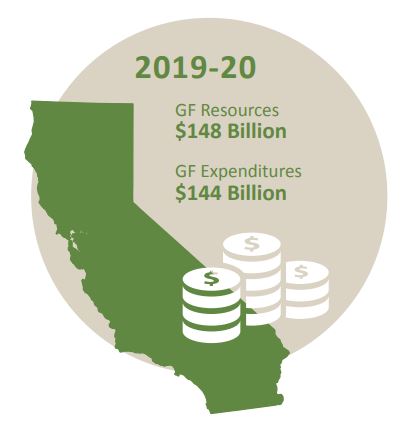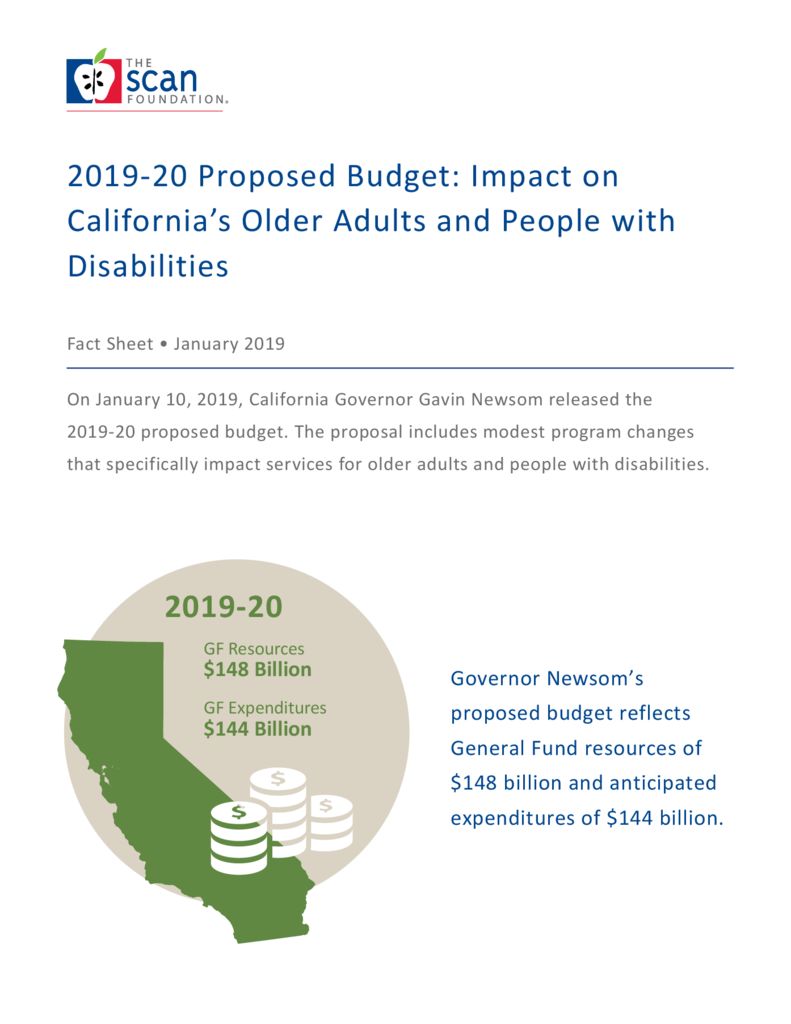2019-20 Proposed Budget: Impact on California’s Older Adults and People with Disabilities
Overview
On January 10, 2019, Governor Gavin Newsom released his 2019-20 proposed budget, outlining the state’s projected revenues and spending plan for the fiscal year beginning on July 1, 2019, and ending June 30, 2020. The proposed budget includes total General Fund (GF) resources of $148 billion and anticipated expenditures of $144 billion, with the rest held in reserve. This is a very different starting point than the previous administration faced in 2011, as California had a significant budget deficit and no “rainy day fund.” The proposed budget reflects no deficit, a Budget Stabilization Account* balance of $15.3 billion, a Safety Net Reserveᵻ balance of $900 million, and plans to address the state’s pension liabilities.2,3

Governor Newsom’s proposed budget reflects General Fund resources of $148 billion and anticipated expenditures of $144 billion.
California Needs a Master Plan for Aging
Governor Newsom’s 2019-20 proposed budget lays out a number of important investments in health care affordability and access, housing, mental health, emergency response, and child care. While these investments impact many older adults and people with disabilities, continued efforts are needed to plan for the breadth of services necessary to support older adults, people with disabilities, and caregivers as California’s population ages. By 2030, the state’s older adult population will increase by 4 million people, and the state’s 4.5 million unpaid family caregivers continue to face significant issues in supporting the needs of their aging loved ones.4,5 California needs a comprehensive Master Plan for Aging to help identify risks, establish priorities, and guide the efficient use of the state’s resources to ensure a stronger California for all.
Californians age 65+ will increase to more than 9 million by 2030, which is 20 times the growth rate of those younger than 65.
Proposals Impacting Older Adults and People with Disabilities
The following items reflect proposals that impact the state’s population of older adults and people with disabilities.ⱡ
- In-Home Supportive Services (IHSS): The IHSS program provides in-home personal assistance to low-income adults who are age 65 and older, blind, or disabled, and to children who are blind or disabled. Services include assistance with bathing, feeding, dressing, and/or domestic services such as shopping , cooking, and housework so that individuals can remain safely in their own homes. The proposed budget estimates that IHSS will serve approximately 564,000 individuals in 2019-20, dedicating $12.7 billion ($4.3 billion GF) for the IHSS program.2 The budget includes: the IHSS program including:
-
- “Permanent” restoration of service-hour reductions: The proposed budget permanently restores the 7 percent reduction applied in 2012 starting on July 1,2019, and dedicates $342.3 million GF for 2019-20.2
- County IHSS maintenance-of-effort: The proposed budget revises the IHSS county-state funding formula methodology negotiated in 2017, reducing county IHSS expenditures and increasing state costs by $241.7 million GF in 2019-20. In future years, when a county negotiates hourly wages above the targeted minimum hourly wage of $15, the non-federal share of cost will be split with the county paying 65 percent and the state paying 35 percent.2
- Electronic visit verification: Under federal law, states are required to implement an electronic visit verification system for personal care services by January 1, 2020, and for home health services by January 1, 2023. The proposed budget includes $34.9 million ($5.3 million GF) for implementation.2
- SSI/SSP: In California, the Supplemental Security Income, or SSI (a federal program that provides a monthly cash benefit to low-income aged, blind, and disabled individuals) is augmented with a State Supplementary Payment (SSP) grant.
On average, 1.22 million people will receive benefits monthly in 2019-20. In 2019, maximum SSI/SSP grant levels are $931 per month for individuals and $1,564 per month for couples.2 These amounts would increase to $950 per month for individuals and $1,593 per month for couples in 2020, including:
-
- Elimination of the SSI cash-out policy: The 2018-19 budget expanded CalFresh (California’s Supplemental Nutrition Assistance Program) eligibility to SSI recipients who had previously been prohibited from participating in the program. Prior to the policy change, SSI/SSP recipients had received a monthly $10 supplement in lieu of CalFresh benefits. Additionally, when households with an SSI/SSP recipient applied for CalFresh, the SSI/SSP income was not included as part of the household income for the eligibility determinations. This is no longer the case. To address the loss of food benefits resulting from this policy change, the 2018-19 budget included one-time funds for affected families. The 2019-20 proposed budget includes $86.7 million GF and makes the offset permanent.2
- SSI advocacy: The Housing and Disability Advocacy Program assists disabled homeless individuals with applying for disability benefit programs. The 2019-20 proposed budget includes $25 million GF on an ongoing basis to continue implementing this program.2
- Alzheimer’s Disease Program Grant Awards: The proposed budget includes $3 million GF annually on an ongoing basis to support Alzheimer ’s disease research, specifically focusing on understanding the prevalence of higher Alzheimer ’s rates in women and communities of color. In addition, this funding will be used to create a Governor’s Task Force on Brain Health.2
- Traumatic Brain Injury Program: The Traumatic Brain Injury Program provides specialized services and supports to individuals who have experienced a traumatic brain injury. In 2018, the program was extended through July 2024.6 The proposed budget includes $1.2 million GF, establishing a more sustainable funding source by switching from the State Penalty Fund to GF.2
- Whole Person Care Pilot: Established through the 1115 Waiver, the Whole Person Care Pilot program is a federal/state partnership that coordinates health, behavioral health, and social services. The proposed budget includes a one-time augmentation of $100 million GF available for use through June 2025. These funds are to match county investments in health and housing services for people with mental illness facing homelessness.2
Next Steps in the Budget Process
California’s 2019-20 Governor’s Budget requires approval by the Senate and the Assembly. The Legislature will deliberate the budget through a series of budget subcommittee hearings in each house, from March through May.7
In May 2019, the governor will release an updated revenue forecast, referred to as the “May Revision,” which accounts for changes in revenues and proposed changes to expenditures within the January budget. Each subcommittee votes on its respective issue area(s) in the budget and submits a report to the full budget committee for a vote. From the floor, each house’s budget bill is referred to a joint budget conference committee where differences between the houses can be resolved. The conference committee votes on a compromise version, which if passed, is sent to the floor of each house simultaneously.7
By law, the Legislature must approve the budget by June 15 in time for the governor to sign it by July 1. California’s constitution requires a majority (50 percent plus one) vote of each house of the Legislature, and a forfeiture in pay to legislators if the budget is not enacted by the June 15 deadline.8 Finally, the governor has the authority to “blue pencil” (reduce or eliminate) any appropriation contained in the budget.7
Key Budget Dates
May 2019 – Release of Governor’s Budget May Revision
June 15, 2019 – Deadline for Legislature to approve final budget
July 1, 2019 – Deadline for Governor to sign the budget
Download the publication for all visuals and complete references.
Continue Reading
This policy brief provides an introduction to The SCAN Foundation’s CLASS Technical Assistance Brief Series, which explores many of the critical issues to be considered for successfully implementing CLASS.
This policy brief describes the broad needs of individuals with disability and the wide range of supportive and environmental solutions that can allow for the most independent living possible. It suggests how findings on social and environmental supports for individuals with disability can inform implementation of CLASS.
This policy brief provides background on the historical development of benefit eligibility triggers in the private long-term care insurance market. Understanding how these triggers came into being can provide important information to those charged with implementing the CLASS Plan.


